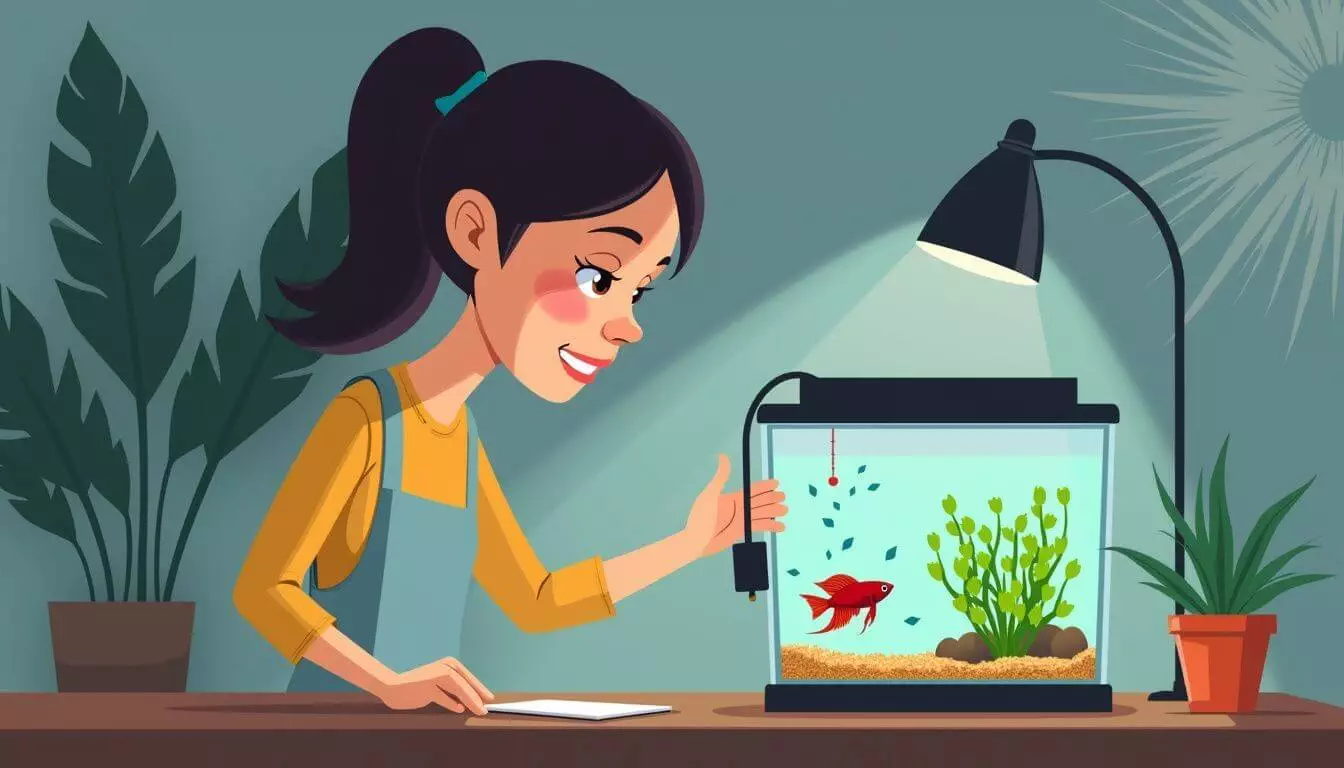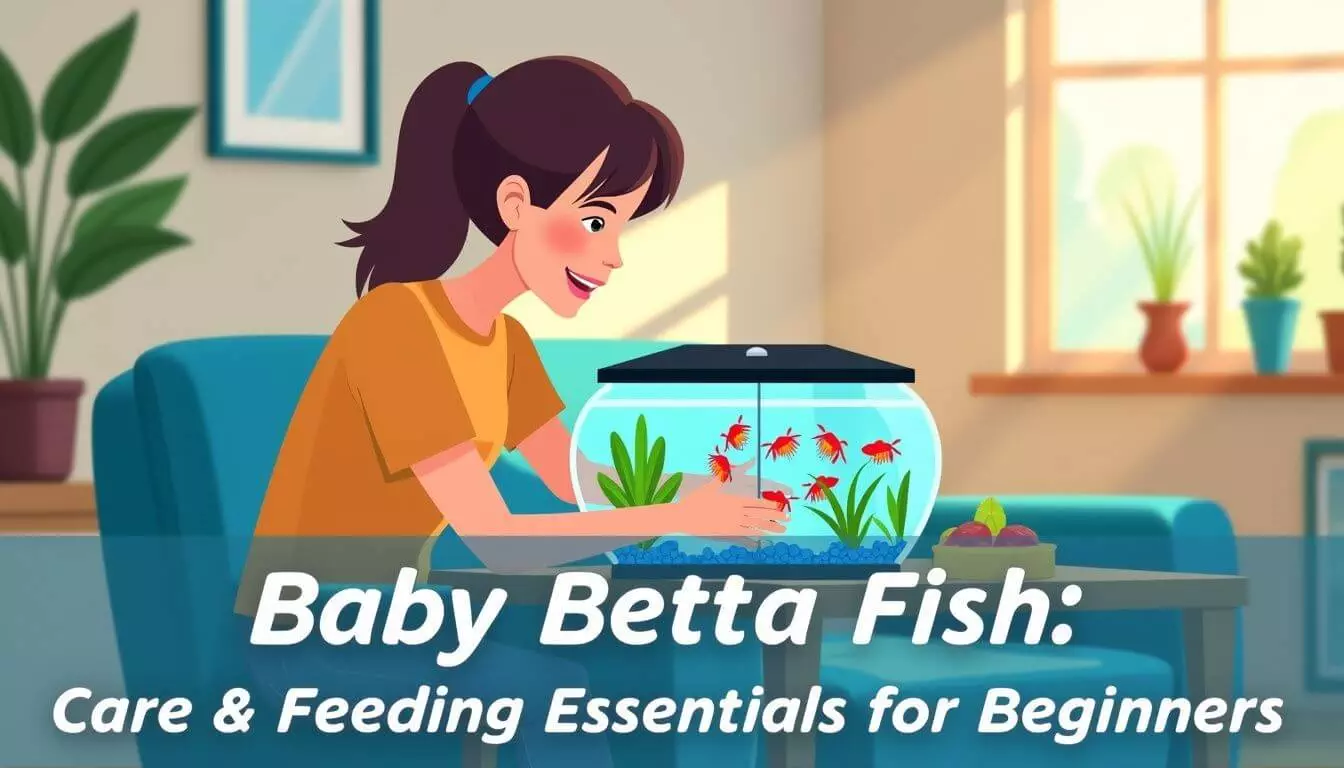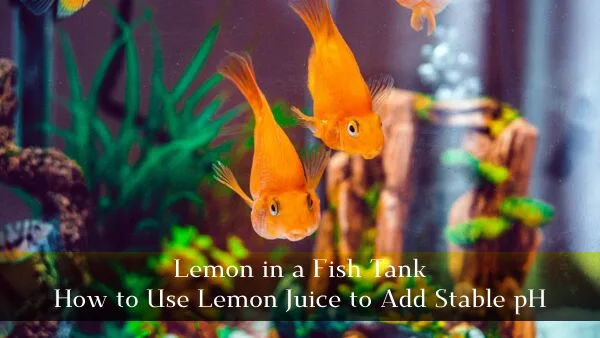Baby betta fish are tiny bundles of joy that can melt your heart. But these little guys need some special TLC to really thrive. Over the years, I’ve raised more baby bettas than I can count, and let me tell you – it’s not as tricky as you might think.
I’m Ronald Farrar, and I’ve made a career as an aquarium tech expert. My two big passions? Capturing the beauty of underwater worlds through my camera lens and giving bettas the best care possible.
In this guide, I’m excited to share my top tips for raising healthy baby bettas. You’ll learn everything from setting up the perfect little home to making sure those tiny mouths get the right food. 3 So, are you ready to jump in and start this rewarding journey?
Key Takeaways
- Baby bettas need a 1-gallon tank or bigger with water at 78-80°F.
- Feed baby bettas small meals 3-4 times a day with crushed pellets and live foods.
- Change 25-50% of the tank water every 2-3 days to keep it clean.
- Use a gentle sponge filter and add soft plants for hiding spots.
- Keep male bettas alone, but females can live together with 2 per liter of water.
Understanding the Basics of Baby Betta Fish Care

I’ve raised many baby bettas, and I can tell you it’s a fun challenge. These tiny fish need special care. They’re part of the gourami family and grow from less than an inch to over 5 inches long.
Baby bettas need warm, clean water and the right food to thrive. I always keep their tank at 78-80°F and use a sponge filter to keep the water clean. 1 For food, I start with baby brine shrimp and slowly add crushed pellets as they grow.
It’s key to feed them often – about 3-4 times a day in small amounts. Now, let’s look at how to set up the perfect tank for your baby betta. 2
Setting Up the Perfect Betta Tank for Baby Bettas
Setting up a tank for baby bettas needs care and attention. Here’s how to create the perfect home for your tiny swimmers:
- Tank size: Choose a 1-gallon tank or larger for each baby betta. This gives them room to grow and explore. 1
- Water temperature: Keep the water between 76-84°F (24-29°C). 80°F (27°C) is best for baby bettas.
- Filtration: Use a gentle sponge filter. It keeps the water clean without creating strong currents.
- Heater: Add a small, adjustable heater to maintain the right temperature.
- Substrate: Use fine, smooth gravel or sand. This prevents injury to delicate fins.
- Decor: Add soft plants and hiding spots. Silk plants or live plants work well. 3
- Lighting: Provide 8-10 hours of soft light daily. Use a timer for consistency.
- Water changes: Change 25-50% of the water every 2-3 days. This keeps the water clean and healthy.
- Water conditioner: Use a good quality conditioner to remove harmful chemicals from tap water.
- Feeding station: Create a designated spot for feeding. This helps keep the tank clean.
Nutrition and Feeding: How to Feed Your Baby Betta
Now that we’ve set up the perfect tank, let’s focus on feeding our baby betta. I’ll share my tips for keeping your little fish healthy and strong. When it comes to feeding your baby betta, it’s best to stick to high-quality, small-sized pellets that are specifically designed for young bettas. These pellets are easier for them to eat and digest, and they provide the essential nutrients they need to grow and thrive. Additionally, it’s important to avoid overfeeding, as this can lead to obesity and other health issues. When determining the right portion size, consider the bumblebee catfish size in relation to your betta’s size, as a general guideline for portion control.
- Offer diverse foods: Baby bettas need a mix of live, frozen, and dry foods. I use crushed pellets, brine shrimp, and worms.
- Feed small amounts often: Give tiny meals 3-4 times daily. This helps prevent bloating and keeps water clean.
- Choose high-protein options: Bettas are carnivores. I pick foods with at least 40% protein content.
- Use live foods wisely: Bloodworms and daphnia are great treats. But don’t rely on them alone. 4
- Crush pellets for small mouths: Adult betta food is too big. I grind it up for my baby fish.
- Watch for overfeeding: Remove uneaten food after 5 minutes. This stops water pollution. 5
- Fast once a week: I skip one day of feeding to help digestion. It’s good for their tummies.
- Adjust as they grow: Increase food size and amount as your betta gets bigger. I change it every few weeks.
- Try frozen foods: Thawed brine shrimp or bloodworms are nutritious. I use these 2-3 times a week.
- Avoid human food: Fish can’t digest our meals. I stick to fish-specific diets only.
Water Quality and Maintenance for Baby Betta Fish
Proper feeding sets the stage for good water quality. I test my baby betta’s water often. I check ammonia, nitrate, and nitrite levels weekly. These tests help me keep the water safe.
I change 25% of the water every few days. This removes waste and keeps the tank clean. 6
I keep the water between 76-81°F. Big temp changes stress baby bettas. I use a heater to keep it steady. Live plants help clean the water naturally. They also give hiding spots. I add plants like java moss or anacharis.
These are easy to grow and safe for bettas. Clean water means healthy, happy baby bettas! 1
Social Life and Environment: Tank Mates and Decor
I keep my betta fish alone in their tanks. Male bettas are very territorial and can fight with other fish. Female bettas can live together, but I’m careful. I put 2 females per liter of water.
This gives them enough space. 7
I add plastic plants to my betta tanks. These plants help my fish feel safe and calm. Before I put new plants in, I clean them well. This stops any bad stuff from getting in the water.
My bettas need at least a 1-gallon tank to be happy and healthy. I make sure their home is big enough for them to swim and explore. 8
Conclusion
Caring for baby bettas is fun and rewarding. You’ll see them grow into beautiful fish. With the right tank, food, and care, your baby betta will thrive. Maintain clean and warm water for optimal health.
Your little fish will soon become a stunning adult betta. Enjoy this special time with your new pet!
FAQs
1. How do I care for baby betta fish?
Baby bettas need warm, clean water. Keep them in a 3-5 gallon tank. Change some water weekly. Feed them tiny bits often. Use a sponge filter to keep the tank clean.
2. What do baby bettas eat?
Baby bettas love live food. Try brine shrimp or micro-worms. You can also use liquid fry food. As they grow, give them crushed flakes or pellets. Feed them 4-5 times a day, but only a little bit each time.
3. How fast do baby bettas grow?
Baby bettas grow fast! They start tiny, about the size of an eyelash. In 3-4 months, they look like mini adults. By 6 months, they’re full-grown. Good food and clean water help them grow well.
4. Can I keep baby bettas together?
Yes, for a short time. But as they grow, they might fight. Bettas are also called Siamese fighting fish for a reason! It’s best to separate them when they’re about 8 weeks old. Each betta needs its own space.
5. How do I know if my baby betta is healthy?
Healthy baby bettas are active and eat well. Their fins should be whole, not torn. Their eyes should be clear. If they look sick or don’t eat, ask a pet store or fish expert for help.
6. When can I put my baby betta in a community tank?
Wait until your betta is full-grown, about 6 months old. Even then, be careful. Not all fish get along with bettas. Avoid fish with long fins or bright colors. Calm, small fish often make good tank mates.
References
- ^ http://www.lovelybettas.com/baby-betta-care
- ^ https://www.petsmart.com/learning-center/fish-care/how-to-care-for-your-betta-fish/A0188.html
- ^ https://www.fishlore.com/aquariummagazine/mar08/betta-tank-setup.htm
- ^ https://www.plantedtank.net/threads/baby-betta-food.1330211/ (2023-07-22)
- ^ https://www.fishlore.com/aquariumfishforum/resources/the-betta-diet-master-guide.207/ (2021-06-21)
- ^ https://bettafish.org/care/ (2024-02-23)
- ^ https://www.ncbi.nlm.nih.gov/pmc/articles/PMC9334006/
- ^ https://www.petmd.com/fish/betta-fish-care-sheet (2023-04-27)






